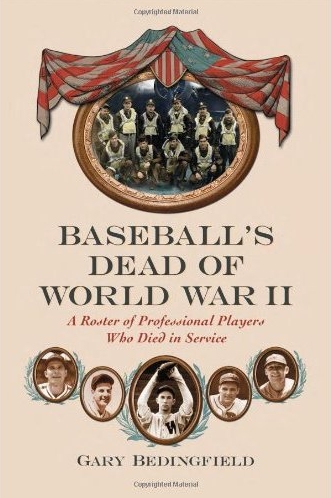

Baseball's Dead of World War II

Baseball’s Dead of World War II
A Roster of Professional Players Who Died in Service
Gary Bedingfield
Print ISBN: 978-0-7864-4454-0
EBook ISBN: 978-0-7864-5820-2
34 photos, appendices, notes, bibliography, index
272pp. softcover (7 x 10) 2010
Reviews
"an impressive and highly useful work of scholarship about a most
noble subject" Spitball
"well-researched...an educational read for baseball fans and
historians alike" Yankees Magazine
"clear writing, interesting baseball history...one of the most
compelling, memorable and enjoyable World War II histories...rich
historical detail...a pleasurable read" America in WWII
There has
never been a baseball book like Baseball's Dead of World War II
A Review by Baseball Historian Bill Swank
There has never been a baseball book like Baseball's Dead of World
War II. The title is as subtle as a fastball in the ribs. Trot to
first base, because reading this book is painful as hell. Try to act
like it doesn't hurt, but it's hard not to cry.
Much has been written about major league stars who served in the
military and lost productive years during the war, but nothing has
ever been chronicled about the unknown minor league players who lost
their lives. Baseball's Dead of World War II will forever change
perceptions of baseball's sacrifice during the Second World War.
This is an emotional and inspirational tribute to these forgotten
men.
In 2007, I heard Gary Bedingfield's keynote address for the "When
Baseball Went to War" conference and exhibition at the National
World War II Museum in New Orleans. Instead of asking for a
traditional moment of silence for the players who died during the
war, Bedingfield proposed a round of applause. Initially the
audience responded politely, but the applause grew into a standing
ovation. The scene is permanently etched in my memory.
The pioneering research in this book is groundbreaking. Whether your
interest is baseball or World War II, Baseball's Dead of World War
II would be a significant addition to your library.
Major league players rarely served in combat, but those who did -
including four Hall of Famers - are acknowledged by Bedingfield.
There are also inspiring stories of minor league players who
overcame serious wartime injuries to fulfill their dreams to play in
the major leagues. Further, many wounded players were unable to
return to baseball, but the focus of this book is on the 127 players
who lost their lives in military service during the war. They fought
and died in all theaters including the following major battles.
Technician Fifth Grade Joe Pinder was posthumously awarded the Medal
of Honor for his bravery during the D-Day landings on Omaha Beach.
Ironically, June 6, 1944 was the sixth anniversary of Private
Forrest "Lefty" Brewer's 1938 no-hitter in the Florida International
League. Brewer, a paratrooper with the 82nd Airborne Division,
parachuted into Normandy and died attacking German positions near
Sainte-Mère-Église. A third minor league player, Elmer Wright, also
lost his life that day.
Nine former minor league players were killed during the Battle of
the Bulge: Ernie Holbrook, Bill Hansen, Hank Nowak, Elmer Wachtler,
Alan Lightner (Alan Wray), Ernie Hrovatic, Paul Mellblom, George
Meyer and Lamar Zimmerman.
Six former ballplayers were among the 6,821 marine fatalities
suffered on Iwo Jima. First Lieutenant Jack Lummus posthumously
received the Medal of Honor for single-handedly taking out three
enemy pillboxes. First Lieutenant Harry O'Neill, who appeared in one
game for the Philadelphia Athletics in 1939, was among the Iwo Jima
casualties.
The only other former major leaguer to die in WWII was Army Air
Force pilot Captain Elmer Gedeon whose B-26B Marauder bomber crashed
in France. Gedeon played briefly with the Washington Senators in
1939.
Five former ballplayers received the Silver Star, three received the
Bronze Star, five the Distinguished Flying Cross and one the Navy
Cross. Ten players received air medals. Most of these decorations
were awarded posthumously.
It is a little known fact that there were over 15,000 flight
training and air transport deaths during World War II. Consistent
with those numbers, sixteen former ballplayers serving in the Army
Air Force, Navy and Marine Corps lost their lives in flight training
and transport accidents.
Perhaps the most recognizable name, minor league prospect Billy
Southworth, Jr., son of Hall of Fame manager Billy Southworth, was
among the first ballplayers to volunteer for military service in
1940. As a B-17 pilot, young Southworth completed his required
number of combat missions in 1943 and returned stateside to become a
training instructor. In 1945, during a routine flight, Major
Southworth's B-29 crashed during an emergency landing at LaGuardia
Field in New York.
Hall of Fame pitcher and WWII combat veteran Bob Feller noted
poignantly, "I'm no hero. Heroes don't come back."
On January 25, 1945, Sgt. Earl "Lefty" Springer was killed in
Nennig, Germany. He is buried in the Luxembourg American Cemetery.
Every year since then, in appreciation for the American soldiers who
gave their lives to liberate his country, local resident Jean
Folschette has placed flowers on Springer's grave. Folschette did
not know the former minor league pitcher.
Gary Bedingfield tracked down the stories of these mostly unknown
former ballplayers so their service and sacrifice would not be
forgotten. Baseball's Dead of World War II is his memorial wreath
for each of their graves.
Bill Swank, San Diego, CA., February 2010